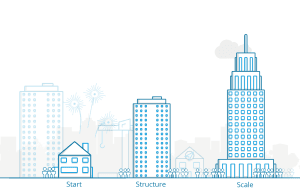How do you maintain momentum in the structure phase?
24 January 2024 • Blog

Organizations that want to reap the benefits of low-code and have started to implement a digital transformation framework eventually enter the structure phase after a run-up in the start-up phase. To leverage the good results and organizational support achieved in the first phase, keeping the momentum in the structure phase is crucial. How do you go about this and what resources can you use to achieve this?
“Low-code application development requires a different, agile approach than traditional software development,” said Charles Bronzwaer, partner at Ciphix. “Agile working with low-code requires an overall change in the way organizations work. Instead of fully thought-out functional designs that describe how an application should work, you start working with user stories that describe the user’s experience. The traditional way of working often results in a highly technical description of processes that can often be interpreted in multiple ways, resulting in an enormous amount of documentation. In agile working, you start much more from the impact of a solution for the user which means that documentation needs to be described less technically.”
The new way of working also has implications in other areas. Because low-code platforms enable the rapid development of applications, space will have to be made in the organization to facilitate that speed. This means that the way organizations look at problems, budgets, planning and even recruitment will have to change.
Provide specialty teams
One of the first steps companies need to take for a successful “structure phase” is to set up specialist low-code teams dedicated to this way of working. Such teams also require new and consistent guidelines that allow them to meet the high expectations. You can achieve this by establishing model guidelines; descriptions and instructions in which you make and record agreements about best practices, security guidelines but also naming and, folder structures, among other things.
Bronzwaer: “These guidelines are important because it allows all teams, now and in the future, to work according to the same principles. The applications that are developed are therefore consistently of high quality and meet the requirements of the organization. Also, in this you lay the foundation for developing secure applications.”
Develop high-quality applications faster
Clear guidelines make it easier to collaborate and share new features because team members always know from each other what guidelines are being followed. It also thus shortens the time it takes for new team members to join the teams. After all, there is already a foundation in place that they can learn from and fall back on. Through peer reviews where new functionality is always checked by a colleague to see if it meets the agreed guidelines you also ensure that those guidelines are actually followed.
Because development teams have a basis for further development with the existing guidelines, this speed gain is also reflected at the start of new projects. This is because there is immediate clarity about the method of working, so there is no need to reinvent the wheel. At most, some additions are necessary. This saves a lot of time.
Bronzwaer: “Rapid development only makes sense if you are not faced with an endless list of errors and bugs at the end of a project. Good model guidelines incorporate best practices that ensure that fewer errors occur. When they do occur, they can be more easily fixed by following the guidelines that provide guidance for debugging. So establishing good model guidelines is an important step to maintain speed in the structure phase and prepare your organization for the scale phase.”
Related
We will help you further!
Replace outdated systems, digitize complex business processes and accelerate innovation.



